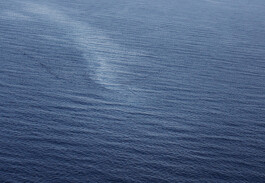SEA PIECES I-IV
c-print, each 60 cm x 90 cm, 2014 / 2015
Four blue photographs show surfaces of water. On closer inspection, they exhibit a certain kind of disturbance, traces of a rough manipulation by image processing. While the movement of the waves is stopped, another dynamic takes space. For underneath, behind, and within that stillness of soothing blue, something seems to have been made to disappear that is now taking shape. Something presses that surface from below or pulls the viewer closer to the picture, a disruption, a noise, which shares little of the meditative, calming effect of the sea. Upon closer inspection the eye detects outlines of floating objects, ghostly lines drawn into the water by their movement. Eyes focus, they search.
Photography incorporates a dialectic of display and concealment, showing and omitting. Historically transformed manipulations in the images themselves, such as the retrospective redaction of Trotsky and Kamenev standing next to Lenin in a photograph of 1920, merely radicalized this principle characteristic of photographic images. In the repetition of such an image intervention, Yvon Chabrowski points to a reduction that is consistently being reproduced in the photographic and linguistic images of the present.
For the SEA PIECES I–IV refer to the (con)fusion of the actual subject of the image and their background: refugees and the sea. In everyday media language, the “flood” of refugees is melded to background of the sea – and with it historical events are being reduced to one uniform surface. Hence, the artist‘s violent treatment of the images seems less cynical than reality: the fact that people seeking refuge – the images´ subject proper – have almost been erased on the one hand mirrors the shortening of flight to a threat. On the other hand, it displays the habituation to these images, going along with a constant suppression. Who thinks of holidays nowadays upon hearing the word “the Mediterranean”?
The traces of the intervention and its picturesque character are counteracting the calmness and authority of the ocean, introducing another type of realism to the photographs. Thus, the radical, cynical gesture of eradication fails: something which was meant to be suppressed remains visible in an uncanny way, and thereby gains in strength.
Vier blaue Fotografien zeigen Wasseroberflächen. Bei näherer Betrachtung weisen sie Störungen auf, Spuren einer groben Manipulation per Bildbearbeitungsprogramm. Während die Bewegung der Wellen angehalten wird, greift eine andere Dynamik Raum. Denn unter, hinter, auf dieser Stille in beruhigendem Blau scheint etwas zum Verschwinden gebracht worden zu sein, dass nun plastisch wird. Es stemmt sich von unten gegen die Oberfläche oder es zieht ins Bild hinein als ein Kriseln und Rauschen, das nunmehr wenig von der meditativen Wirkung des Meeresrauschens hat. Auch entdeckt das Auge Umrisse von Schwimmkörpern; es macht Linien aus, die deren Bewegung ins Wasser zeichnete. Es forscht, fokussiert sich.
Der Fotografie ist eine Dialektik von Zeigen und Verbergen, Aufweisen und Ausschneiden inhärent. Historisch gewordene Manipulationen im Bild selbst, etwa die nachträgliche Löschung Trotzkis und Kamenews vom Holzpodest neben Lenin in einer Aufnahme aus dem Jahr 1920, radikalisierten dieses Verhältnis lediglich. Yvon Chabrowski macht ihrerseits in der Wiederholung eines solchen Eingriffs eine Reduktion jenseits der direkten Bildmanipulation offenbar, die in den fotografischen und sprachlichen Bildern der Gegenwart konsequent reproduziert wird.
Denn die SEESTÜCKE I-IV rekurrieren auf die Verschmelzung des eigentlichen Bildsujets mit seinem Hintergrund: Flüchtlinge und das Meer. In der medialen Alltagssprache von Flüchtlingswelle oder -flut ist diese Verschmelzung bereits vollbracht und mit ihr das zeithistorische Geschehen auf eine Ebene reduziert. So reicht der gewaltsame Umgang der Künstlerin mit den Bildern doch an den realen Zynismus nicht heran: Dass das eigentliche Bildthema – die Flüchtenden – für das vermeintliche Verständnis der Bilder beinahe überflüssig ist, spiegelt jene Verkürzung von Flucht zur Bedrohung einerseits, die Gewöhnung an diese Bilder, die mit der stetigen Verdrängung einhergeht andererseits. Wer denkt auf das Stichwort "Mittelmeer" heute noch an Urlaub?
So wirken die Spuren des Eingriffs und deren malerischer Charakter der Ruhe und Autorität des Meeresganges entgegen und stellen eben dadurch den Realismus der Aufnahmen scharf – und der radikale wie zynische Gestus des Ausradierens scheitert: Etwas, das verdrängt werden sollte, bleibt auf eine unheimliche Weise sichtbar und gewinnt dadurch an Kraft.
text by Carolin Krahl
work by Yvon Chabrowski





